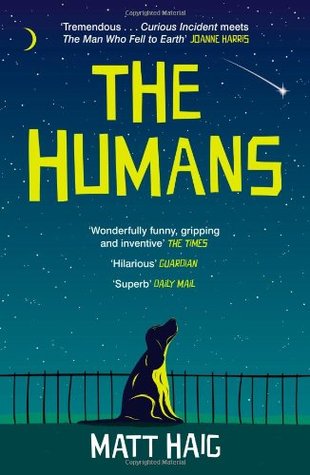Matt Haig's The Humans, and why it didn't work for me

Plot Summary
Matt Haig’s ‘The Humans’ is about an alien protagonist who comes to earth to prevent humans from making a particular scientific discovery which could threaten the stability of the universe. The alien’s mission is to identify and kill anyone with knowledge of the discovery, starting with Richard– a professor of Mathematics who made the discovery– and all those the professor shared details of his discovery with, including his wife, son, and colleagues. The alien goes about his mission, taking on Richard’s physical form and living in Richard’s house with his wife and son, and along the way comes to appreciate humanity through adventures like falling in love with the professor’s wife and becoming a father figure to the professor’s moody and neglected teenage son.
Both as a work of sci-fi and a work of emotive fiction, ‘The Humans’ falls short of potential. Haig neglects to build the world of the alien’s host society leading to an unconvincing decision by the alien protagonist to become a human and to give up his alien super-powers. Haig also ignores the internal emotional world of his human characters making them feel like usherers just there to move the plot along.
World-building inside and outside
In sci-fi works involving civilizations significantly different from human civilization, I usually expect the author to do a bit of world-building, and to show me how these alien societies grew, evolved, and reached their current stage of development. Such world-building can often provide fresh perspectives into the norms and follies of our mortal lives. For example, in the Three Body Problem trilogy, Cixin Liu creates the alien race of ‘tri-solarians’, who communicate by transparently broadcasting their thoughts, rather than sharing a processed version of these thoughts through mediums of words or sounds. This ‘open transmission’ mode of communication means that tri-solarians cannot ‘lie’, and do not even have the concept of lies. World-building,if done well, can also help paint a picture of the internal mental world of alien characters, by showing how they have adapted to their external worlds.
Haig disappoints this expectation by painting the alien society in extremely broad strokes. We are told that the alien society has transcended scarcity, irrational emotions, and death– they are technological geniuses who have achieved immortality and have been around for millions of years. The alien society disregards personal bonds, marital and familial, with rational thought trumping all else as the sole organising principle. Haig could’ve built on these broad ideas to explore how life forms and societies evolve in the absence of scarcity and mortality. When you’re not afraid of want or death, what does life look like for you? In such a society, how do you convince members to sacrifice and put the group over the individual? What does immortality and the consequent infinite wisdom do to an individual’s sense of self and place in the universe?
Life without death offers a rich vein of ideas to explore as so much of the narrative around the meaning and purpose of human existence is predicated on the inveitability of death and the uncertainty of an afterlife. What if death no longer haunted us, and we were immortal– would we still have to struggle with questions of meaning and purpose? How would we change if we became, quite literally, the masters of our universe? Will we still be able to empathise with ‘lesser’ sentient beings struggling with mortality and material scarcity? Haig spurns engaging with these questions, and as a result I’m left unconvinced by the alien’s decision to renounce his own immortality and super-human abilities, and to become a human.
Haig shows the alien’s view of humans evolving over a sequence of encounters with human fear and love, including episodes involving physical assaults of Richard’s colleague and son, followed by the affection other humans show towards the victims and towards the alien himself. However, if we buy Haig’s sketch of life in the alien host society, this transofrmation begins to feel a bit suspect. For starters how is our alien protagonist will able to identify and acknowledge emotional expressions such as affection and fear. There are no equivalent references for the alien to draw on. In other places along the book, the alien’s expression of gender identity is too conveniently similar to that of a stereotypical human male– reticenct, selfish, and prone to bouts of narcissm. It’s almost as if the alien protagonist is actually just a long lost human finally discovering his true family. Haig seems to count on the reader to anthropormorphize the alien so as to impute the ability to recognise and acknowledge human emotions.
Similarly grudging is Haig’s attention to the emotional world of other characters. While the alien protagonist seems to conveniently fit the mould of a typical human male, characters like his wife and son do not exist independent of the main protagonist. We do not get to see or feel what goes on in their minds other than in relation to the protagonist. Another member in a reading group I attend quipped that the dog in Richard’s household had a more fleshed out internal life than most characters.